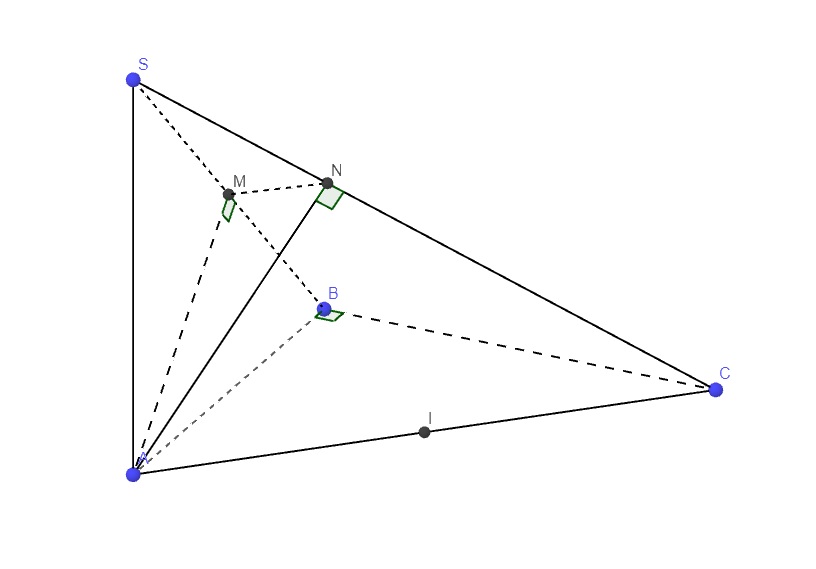Cho \(\overrightarrow{v}\)=(-2;3), đường thẳng d: 2x-3y+3=0, đường thẳng d1: 2x-3y-5=0. Tìm toạ độ của \(\overrightarrow{\text{w}}\) có giá vuông góc với đường thẳng d để d1 là ảnh của d qua phép tịnh tiến T\(\overrightarrow{\text{w}}\)
Hãy nhập câu hỏi của bạn vào đây, nếu là tài khoản VIP, bạn sẽ được ưu tiên trả lời.


1.
\(cos\left(\widehat{\overrightarrow{u};\overrightarrow{v}}\right)=\dfrac{\overrightarrow{u}.\overrightarrow{v}}{\left|\overrightarrow{u}\right|.\left|\overrightarrow{v}\right|}=\dfrac{10}{10.\sqrt{2}}=\dfrac{1}{\sqrt{2}}\)
\(\Rightarrow\left(\widehat{\overrightarrow{u};\overrightarrow{v}}\right)=45^0\)
2.
a.
\(\left\{{}\begin{matrix}SA\perp\left(ABC\right)\Rightarrow SA\perp BC\\AB\perp BC\left(gt\right)\end{matrix}\right.\) \(\Rightarrow BC\perp\left(SAB\right)\) (1)
Mà \(BC=\left(SBC\right)\cap\left(ABC\right)\Rightarrow\widehat{SBA}\) là góc giữa (SBC) và (ABC)
\(tan\widehat{SBA}=\dfrac{SA}{AB}=1\Rightarrow\widehat{SBA}=45^0\)
b.
Từ (1) \(\Rightarrow BC\perp AM\)
Mà \(AM\perp SB\left(gt\right)\) \(\Rightarrow AM\perp\left(SBC\right)\) (2)
\(\Rightarrow AM\perp MN\Rightarrow\Delta AMN\) vuông tại M
Từ (2) \(\Rightarrow AM\perp SC\), mà \(SC\perp AN\left(gt\right)\)
\(\Rightarrow SC\perp\left(AMN\right)\) (3)
Lại có \(SA\perp\left(ABC\right)\) theo giả thiết
\(\Rightarrow\) Góc giữa (AMN) và (ABC) bằng góc giữa SA và SC hay là góc \(\widehat{ASC}\)
\(AC=\sqrt{AB^2+BC^2}=a\sqrt{2}\)
\(\Rightarrow tan\widehat{ASC}=\dfrac{AC}{SA}=\sqrt{2}\Rightarrow\widehat{ASC}\approx54^044'\)
Từ (3) \(\Rightarrow AN\) là hình chiếu vuông góc của AC lên (AMN)
\(\Rightarrow\widehat{CAN}\) là góc giữa AC và (AMN)
Mà \(\widehat{CAN}=\widehat{ASC}\) (cùng phụ \(\widehat{ACS}\)) \(\Rightarrow\widehat{CAN}=...\)
c.
\(\left\{{}\begin{matrix}IC=\dfrac{1}{2}AC\left(gt\right)\\AI\cap\left(SBC\right)=C\end{matrix}\right.\) \(\Rightarrow d\left(I;\left(SBC\right)\right)=\dfrac{1}{2}d\left(A;\left(SBC\right)\right)\)
Mà từ (2) ta có \(AM\perp\left(SBC\right)\Rightarrow AM=d\left(A;\left(SBC\right)\right)\)
\(SA=AB\left(gt\right)\Rightarrow\Delta SAB\) vuông cân tại A
\(\Rightarrow AM=\dfrac{1}{2}SB=\dfrac{a\sqrt{2}}{2}\Rightarrow d\left(I;\left(SBC\right)\right)=\dfrac{1}{2}AM=\dfrac{a\sqrt{2}}{4}\)

\(\overrightarrow{u}.\overrightarrow{v}=2.1+a.\left(-1\right)=2-a\)
\(\Rightarrow2-a=1\Rightarrow a=1\)

Lời giải:
a)
\(\overrightarrow{x}=\overrightarrow{u}-\overrightarrow{v}=(1-2, 2-2,3-(-1))=(-1,0,4)\)
b)
\(\overrightarrow{x}=\overrightarrow{u}-\overrightarrow{v}+2\overrightarrow{w}=(1-2+2.4,2-2+2.0; 3-(-1)+2(-4))\)
\(=(7, 0, -4)\)
c)
\(\overrightarrow{x}=2\overrightarrow{u}+4\overrightarrow{v}-\overrightarrow{w}=(2.1+4.2-4, 2.2+4.2-0, 2.3+4.(-1)-(-4))\)
\(=(6,12,6)\)
d)
\(2\overrightarrow{x}=3\overrightarrow{u}+\overrightarrow{w}=3(1,2,3)+(4,0,-4)=(3.1+4, 3.2+0,3.3+(-4))\)
\(=(7,6,5)\Rightarrow \overrightarrow{x}=(\frac{7}{2}, 3, \frac{5}{2})\)
e)
\(3\overrightarrow{x}=-2\overrightarrow{u}-\overrightarrow{v}+\overrightarrow{w}=-2(1,2,3)-(2,2,-1)+(4,0,-4)\)
\(=(-2,-4,-6)-(2,2,-1)+(4,0,-4)=(-2-2+4,-4-2+0,-6-(-1)+(-4))\)
\(=(0,-6,-9)\Rightarrow \overrightarrow{x}=(0,-2,-3)\)
trần phi yến: bạn xem lại quy tắc cộng trừ vecto trong sách là sẽ làm đc.

vì \(\overrightarrow{W}\) có giá vuông góc với đường thẳng \(d\) nên ta đặc \(\overrightarrow{W}\left(2k;-3k\right)\)
theo công thức ta có : \(\left\{{}\begin{matrix}x'=x+2k\\y'=y-3k\end{matrix}\right.\Rightarrow\left\{{}\begin{matrix}x=x'-2k\\y=y'+3k\end{matrix}\right.\)
\(\Rightarrow2\left(x'-2k\right)-3\left(y+3k\right)+3=0\)
\(\Leftrightarrow2x'-4k-3y'-9k+3=0\Leftrightarrow2x'-3y'-13k+3\left(1\right)\)
để \(\left(1\right)\) là đường thẳng \(d\) thì : \(-13k+3=-5\Leftrightarrow k=\dfrac{8}{13}\)
\(\Rightarrow\overrightarrow{W}\left(\dfrac{16}{13};-\dfrac{24}{13}\right)\) vậy \(\overrightarrow{W}\left(\dfrac{16}{13};-\dfrac{24}{13}\right)\)